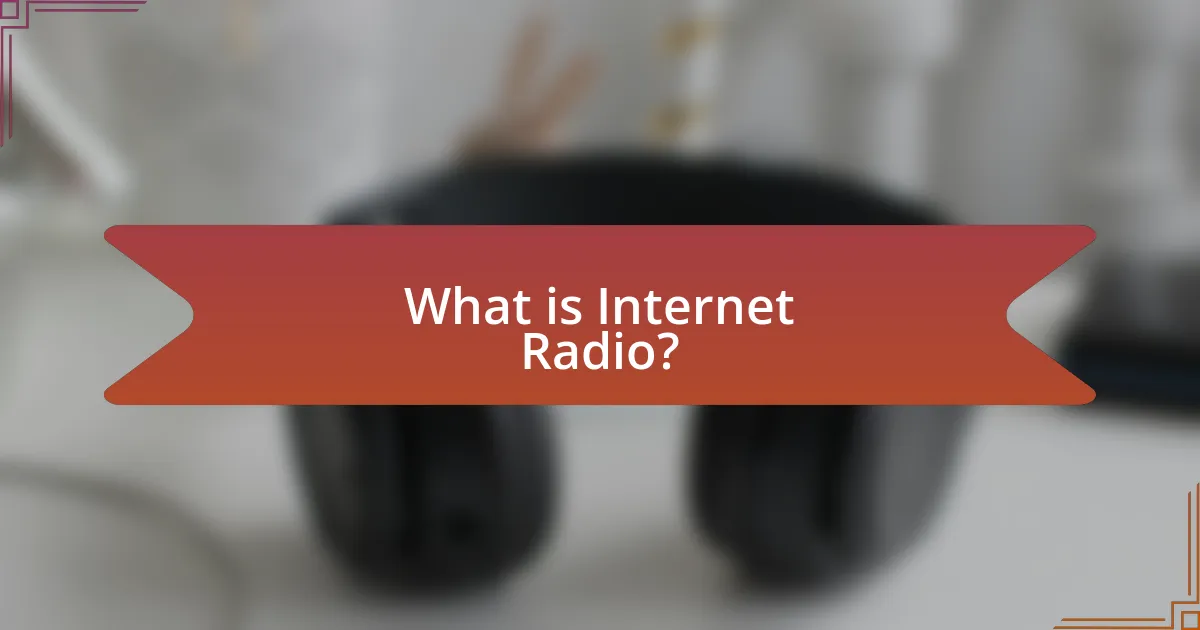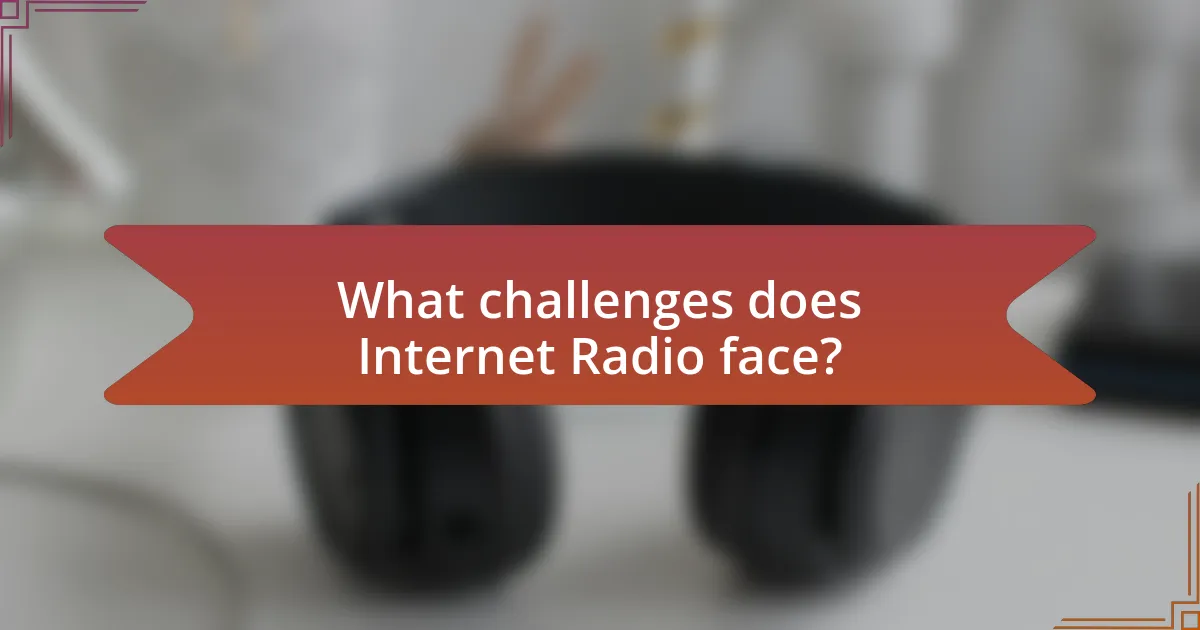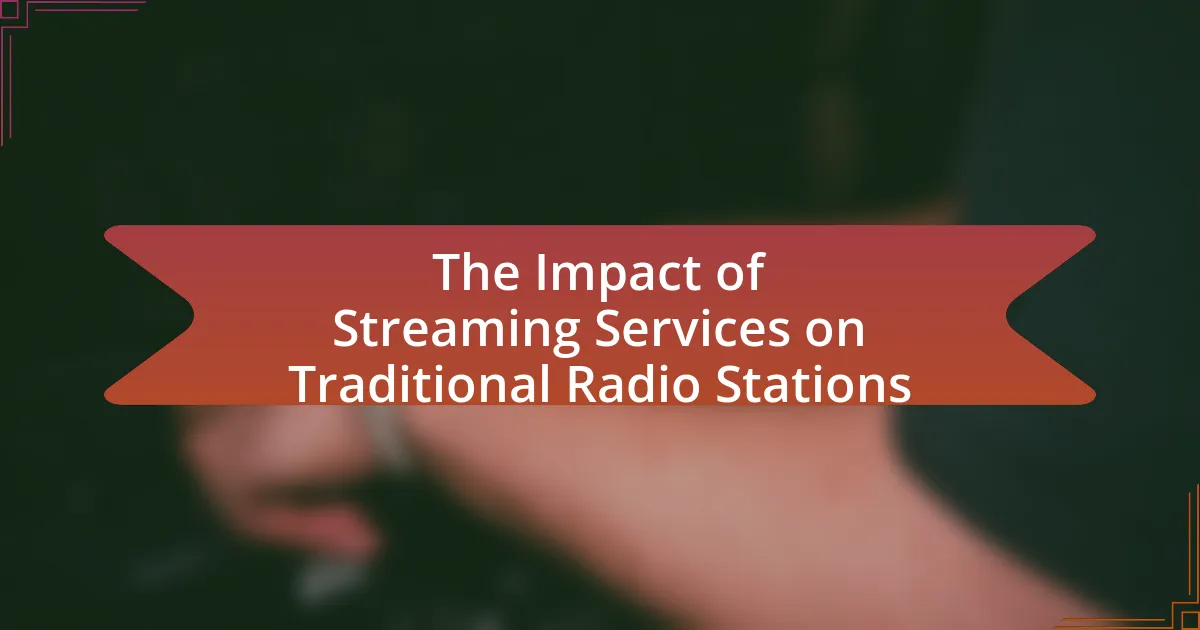The article examines the rise of Internet radio, a digital audio service that streams content globally via the internet, contrasting it with traditional radio’s reliance on terrestrial signals. It highlights the growing popularity of Internet radio, with 41% of Americans aged 12 and older listening as of 2021, and discusses key features such as accessibility, diverse content, interactivity, and personalization. The article also addresses the technologies enabling Internet radio, the impact of the internet’s evolution on its growth, and the challenges it faces, including licensing costs and competition from traditional media. Additionally, it explores opportunities for content creators and advertisers, emphasizing the importance of community engagement and the metrics used to measure advertising effectiveness.

What is Internet Radio?
Internet radio is a digital audio service that streams live or pre-recorded content over the internet. Unlike traditional radio, which relies on terrestrial signals, internet radio utilizes online platforms to reach listeners globally, allowing for a diverse range of programming and accessibility. According to a report by the Pew Research Center, as of 2021, approximately 41% of Americans aged 12 and older listen to internet radio, highlighting its growing popularity and the shift in how audiences consume audio content.
How does Internet Radio differ from traditional radio?
Internet radio differs from traditional radio primarily in its delivery method and accessibility. While traditional radio broadcasts over the airwaves using analog signals, internet radio streams audio content via the internet, allowing listeners to access a wider variety of programming from anywhere with an internet connection. This shift enables internet radio to offer on-demand content, personalized playlists, and a global reach, contrasting with the localized and scheduled nature of traditional radio broadcasts. Additionally, internet radio often incorporates interactive features, such as user-generated content and real-time feedback, which are not typically available in traditional radio formats.
What technologies enable Internet Radio broadcasting?
Internet Radio broadcasting is enabled by several key technologies, including streaming protocols, audio codecs, and server infrastructure. Streaming protocols such as Icecast and Shoutcast facilitate the transmission of audio over the internet, allowing users to access live broadcasts. Audio codecs like MP3, AAC, and Ogg Vorbis compress audio files for efficient transmission without significant loss of quality. Additionally, server infrastructure, including cloud-based solutions, supports the hosting and distribution of content to a global audience, ensuring scalability and reliability. These technologies collectively empower Internet Radio by providing the necessary tools for real-time audio delivery and accessibility.
How has the evolution of the internet influenced Internet Radio?
The evolution of the internet has significantly transformed Internet Radio by enabling global accessibility and diverse content delivery. Initially, traditional radio was limited by geographical boundaries, but the advent of high-speed internet and streaming technologies has allowed Internet Radio to reach audiences worldwide, breaking down these barriers. For instance, platforms like Spotify and Pandora have emerged, offering personalized music experiences and access to a vast library of content, which traditional radio could not provide. Additionally, the rise of social media and mobile applications has facilitated real-time interaction between listeners and broadcasters, enhancing user engagement. According to a report by the Pew Research Center, as of 2021, 41% of Americans reported listening to online radio, showcasing the growing popularity and influence of Internet Radio in the digital age.
What are the key features of Internet Radio?
The key features of Internet Radio include accessibility, diverse content, interactivity, and personalization. Accessibility allows users to listen from anywhere with an internet connection, making it available on various devices such as smartphones, tablets, and computers. Diverse content encompasses a wide range of genres and formats, including music, talk shows, and podcasts, catering to varied listener preferences. Interactivity enables listeners to engage with content through features like live chats, requests, and social media integration. Personalization allows users to create custom playlists and receive tailored recommendations based on their listening habits, enhancing the overall user experience. These features collectively contribute to the growing popularity of Internet Radio, as evidenced by the increasing number of listeners and platforms available globally.
How does streaming quality impact listener experience?
Streaming quality significantly impacts listener experience by influencing audio clarity, buffering times, and overall satisfaction. High streaming quality provides clearer sound and richer detail, enhancing the enjoyment of music and spoken content. Conversely, low streaming quality can lead to distorted audio and interruptions, which detract from the listening experience. Research indicates that listeners are more likely to abandon a stream if buffering occurs, with studies showing that 47% of users expect a video to load in two seconds or less. This expectation translates to audio streaming as well, where delays can frustrate users and lead to decreased engagement. Thus, streaming quality is crucial for maintaining listener retention and satisfaction in the context of internet radio.
What role do playlists and on-demand content play in Internet Radio?
Playlists and on-demand content are essential components of Internet Radio, enhancing user engagement and personalization. Playlists allow listeners to access curated music selections that align with their preferences, while on-demand content provides the flexibility to listen to specific tracks or shows at any time. According to a 2021 report by Statista, 62% of Internet radio users prefer on-demand content, indicating a significant demand for personalized listening experiences. This shift towards user-centric models has led Internet radio platforms to adopt features that cater to individual tastes, ultimately driving listener retention and satisfaction.
What are the historical milestones in the rise of Internet Radio?
The historical milestones in the rise of Internet Radio include the launch of the first Internet radio station, which was Broadcast.com in 1995, marking the beginning of streaming audio online. In 1999, the introduction of the RealNetworks streaming technology allowed for more efficient audio delivery, significantly enhancing user experience. The Telecommunications Act of 1996 facilitated the growth of online broadcasting by deregulating radio ownership, leading to an increase in Internet radio stations. In 2005, the advent of podcasting further revolutionized the medium, allowing users to download and listen to audio content on demand. By 2010, services like Pandora and Spotify emerged, popularizing personalized streaming and reshaping the music industry. These milestones collectively illustrate the evolution and expansion of Internet Radio as a significant platform for audio content distribution.
What significant events marked the beginning of Internet Radio?
The beginning of Internet Radio was marked by the launch of the first streaming audio service in 1993, known as “Internet Talk Radio,” which allowed users to listen to live broadcasts over the internet. This event was significant as it demonstrated the potential of the internet for audio broadcasting, paving the way for future developments in online radio. Additionally, in 1995, the establishment of the first Internet radio station, “Radio Free Virgin,” further solidified the concept of streaming radio, allowing users to access a variety of music and talk shows online. These events laid the groundwork for the growth of Internet Radio, leading to the diverse platforms and services available today.
How have listener demographics changed over time?
Listener demographics have shifted significantly over time, particularly with the rise of internet radio. Historically, traditional radio audiences were predominantly older adults, but recent trends indicate a younger demographic is increasingly engaging with online platforms. For instance, a 2021 report by Edison Research revealed that 54% of internet radio listeners are aged 18-34, compared to only 28% in 2010. This shift is attributed to the accessibility of streaming services and the integration of mobile technology, which has made it easier for younger audiences to discover and consume diverse audio content. Additionally, the growth of niche genres and personalized playlists has attracted a more varied listener base, further diversifying the demographics of internet radio audiences.

What opportunities does Internet Radio present?
Internet radio presents opportunities for diverse content creation, global reach, and targeted advertising. It allows creators to broadcast niche programming that may not be viable on traditional radio, catering to specific audiences. According to a report by Statista, the global internet radio market is projected to grow significantly, indicating increasing listener engagement and potential revenue streams. Additionally, internet radio enables advertisers to reach specific demographics through data-driven targeting, enhancing marketing effectiveness. This combination of unique content and precise advertising capabilities positions internet radio as a valuable platform in the evolving media landscape.
How can Internet Radio benefit content creators?
Internet radio benefits content creators by providing a platform for wider audience reach and engagement. Unlike traditional radio, internet radio allows creators to broadcast their content globally, reaching listeners who may not have access to local stations. This expanded reach can lead to increased brand visibility and potential monetization opportunities through advertising, sponsorships, and listener donations. According to a report by Statista, the number of internet radio listeners in the United States is projected to reach 164 million by 2025, highlighting the growing audience for content creators. Additionally, internet radio offers creators the ability to interact with their audience in real-time through live chats and social media integration, fostering a community around their content.
What monetization strategies are available for Internet Radio hosts?
Internet Radio hosts can utilize several monetization strategies, including advertising, subscription models, merchandise sales, and crowdfunding. Advertising involves selling ad space during broadcasts, which can generate significant revenue; for instance, according to a report by eMarketer, U.S. digital audio ad spending is projected to reach $4.8 billion by 2024. Subscription models allow listeners to pay for premium content or ad-free experiences, providing a steady income stream. Merchandise sales, such as branded apparel or accessories, can also contribute to revenue. Additionally, crowdfunding platforms like Patreon enable fans to support their favorite hosts directly, fostering community engagement while generating funds. These strategies collectively enhance the financial viability of Internet Radio hosting.
How does Internet Radio facilitate niche content discovery?
Internet Radio facilitates niche content discovery by providing a diverse range of programming that caters to specific interests and communities. Unlike traditional radio, which often focuses on mainstream content, Internet Radio allows independent creators and smaller stations to broadcast specialized genres, such as indie music, niche talk shows, or cultural programming. This accessibility enables listeners to find content that aligns with their unique preferences, as evidenced by platforms like TuneIn and Mixcloud, which host thousands of channels across various genres. Additionally, algorithms and user-generated playlists on these platforms enhance the discovery process by recommending content based on listening habits, further supporting the exploration of niche interests.
What advantages does Internet Radio offer to advertisers?
Internet Radio offers advertisers targeted audience reach, cost-effectiveness, and enhanced engagement. Advertisers can utilize data analytics to target specific demographics, ensuring their messages reach the most relevant listeners. According to a report by eMarketer, digital audio advertising, including Internet Radio, is projected to grow significantly, with spending expected to reach $4.6 billion by 2023, demonstrating its increasing value to advertisers. Additionally, Internet Radio allows for interactive ad formats, fostering greater listener engagement compared to traditional radio, which can lead to higher conversion rates.
How does targeted advertising work in Internet Radio?
Targeted advertising in Internet Radio works by utilizing listener data to deliver personalized ads based on demographics, interests, and listening habits. Internet radio platforms collect data through user profiles, listening history, and engagement metrics, allowing advertisers to segment audiences effectively. For instance, a study by eMarketer indicates that targeted ads can increase engagement rates by up to 50% compared to non-targeted ads, demonstrating the effectiveness of this approach. This data-driven strategy ensures that advertisers reach the most relevant audience, maximizing the impact of their campaigns.
What metrics are used to measure the effectiveness of Internet Radio advertising?
The effectiveness of Internet Radio advertising is measured using several key metrics, including reach, frequency, engagement, and conversion rates. Reach quantifies the number of unique listeners exposed to an advertisement, while frequency indicates how often those listeners hear the ad within a specific timeframe. Engagement metrics, such as listener interaction and time spent listening, provide insights into how well the content resonates with the audience. Conversion rates track the percentage of listeners who take a desired action, such as visiting a website or making a purchase after hearing the ad. These metrics collectively help advertisers assess the impact and return on investment of their Internet Radio campaigns.
What role does community engagement play in Internet Radio?
Community engagement plays a crucial role in Internet Radio by fostering listener loyalty and enhancing content relevance. Engaged communities contribute feedback, share content, and participate in discussions, which helps stations tailor their programming to audience preferences. For instance, research indicates that stations with active listener involvement report higher audience retention rates, as community-driven content often resonates more deeply with listeners. This dynamic not only strengthens the station’s identity but also creates a sense of belonging among listeners, ultimately driving growth and sustainability in the competitive landscape of Internet Radio.
How can Internet Radio foster listener interaction?
Internet radio can foster listener interaction through real-time communication features such as live chats, social media integration, and listener call-ins. These interactive elements allow listeners to engage directly with hosts, share feedback, and participate in discussions, enhancing the overall listening experience. For instance, platforms like TuneIn and iHeartRadio enable users to comment on shows and interact via social media, creating a community around the broadcast. Additionally, many internet radio stations utilize polls and surveys during live shows to gather listener opinions, further promoting engagement and interaction.
What are the benefits of building a loyal listener community?
Building a loyal listener community enhances engagement and retention for internet radio platforms. This community fosters a sense of belonging among listeners, which can lead to increased loyalty and consistent listenership. According to a study by the Pew Research Center, 70% of listeners are more likely to engage with content when they feel a connection to the community surrounding it. Additionally, a loyal listener base can provide valuable feedback, helping creators tailor content to audience preferences, ultimately driving growth and improving content quality.

What challenges does Internet Radio face?
Internet radio faces several challenges, including licensing costs, competition from other media, and technological barriers. Licensing costs are significant, as internet radio stations must pay royalties to music rights organizations, which can be prohibitively expensive for smaller stations. Competition from traditional radio, streaming services, and podcasts further complicates the landscape, making it difficult for internet radio to attract and retain listeners. Additionally, technological barriers such as inconsistent internet access and the need for reliable streaming infrastructure can hinder growth and accessibility. These factors collectively impact the sustainability and reach of internet radio.
What regulatory hurdles impact Internet Radio?
Internet radio faces several regulatory hurdles, primarily related to licensing and copyright issues. These hurdles include the requirement for internet radio stations to obtain performance rights licenses from organizations like ASCAP, BMI, and SESAC, which can be costly and complex. Additionally, the Digital Millennium Copyright Act (DMCA) imposes strict rules on the use of copyrighted music, requiring internet radio operators to pay royalties based on their revenue and the number of songs played. Furthermore, compliance with Federal Communications Commission (FCC) regulations can also present challenges, particularly regarding content restrictions and broadcasting standards. These regulatory frameworks create significant barriers for new entrants in the internet radio market, impacting their operational viability and growth potential.
How do licensing requirements affect Internet Radio operations?
Licensing requirements significantly impact Internet Radio operations by dictating the legal framework within which these platforms must operate. Internet Radio stations are required to obtain licenses for music broadcasting, which involves paying royalties to copyright holders. For instance, in the United States, the Digital Millennium Copyright Act (DMCA) mandates that Internet Radio operators secure licenses from organizations like ASCAP, BMI, and SESAC to legally stream music. Failure to comply with these licensing requirements can result in hefty fines and legal action, thereby affecting the financial viability and operational sustainability of Internet Radio stations.
What are the implications of copyright laws for Internet Radio stations?
Copyright laws significantly impact Internet Radio stations by requiring them to obtain licenses for the music they broadcast. These licenses ensure that artists and copyright holders receive compensation for their work, which can lead to increased operational costs for Internet Radio stations. For instance, the Digital Millennium Copyright Act (DMCA) mandates that Internet Radio stations pay performance royalties to organizations like SoundExchange, which can amount to thousands of dollars annually, depending on the station’s audience size and the amount of music played. Additionally, failure to comply with copyright laws can result in legal penalties, including fines and the potential shutdown of the station. Thus, adherence to copyright regulations is crucial for the sustainability and legality of Internet Radio operations.
How does competition affect Internet Radio’s growth?
Competition significantly accelerates Internet Radio’s growth by driving innovation and improving content quality. As multiple platforms vie for listener attention, they enhance user experience through better technology, diverse programming, and personalized content. For instance, the rise of platforms like Spotify and Pandora has led to increased investment in original content and user engagement strategies, which has expanded the overall audience for Internet Radio. According to a report by Statista, the global Internet radio market is projected to grow from $2.5 billion in 2020 to $4.5 billion by 2025, illustrating how competitive dynamics contribute to market expansion.
What challenges do Internet Radio stations face from traditional media?
Internet radio stations face significant challenges from traditional media, primarily in terms of audience reach and advertising revenue. Traditional media, such as AM/FM radio, has established listener bases and brand recognition, making it difficult for internet radio to attract the same level of audience engagement. According to the Nielsen Audio report, traditional radio still commands a larger share of the audio market, with over 90% of Americans tuning in weekly, compared to the growing but still smaller audience for internet radio. Additionally, traditional media often has more robust advertising budgets and established relationships with advertisers, which can limit the financial resources available to internet radio stations. This competitive disadvantage in both audience size and advertising revenue creates substantial hurdles for internet radio in gaining market share and sustainability.
How do emerging technologies influence competition in the Internet Radio space?
Emerging technologies significantly influence competition in the Internet Radio space by enabling enhanced user experiences and personalized content delivery. Innovations such as artificial intelligence and machine learning allow platforms to analyze listener preferences, leading to tailored playlists and targeted advertising, which can attract and retain audiences more effectively than traditional radio. For instance, services like Spotify and Pandora utilize algorithms to curate music based on user behavior, creating a competitive edge over conventional radio stations that lack such capabilities. Additionally, advancements in streaming technology improve audio quality and reduce latency, further enhancing user satisfaction and engagement. This technological evolution fosters a dynamic environment where Internet radio platforms must continuously innovate to maintain their market position against both established broadcasters and new entrants.
What technical challenges do Internet Radio platforms encounter?
Internet Radio platforms encounter several technical challenges, including bandwidth limitations, latency issues, and content delivery network (CDN) reliability. Bandwidth limitations can restrict the quality of audio streaming, affecting user experience, especially in areas with poor internet connectivity. Latency issues can lead to delays in audio transmission, which disrupts real-time interactions during live broadcasts. Additionally, the reliability of CDNs is crucial; if a CDN fails or experiences downtime, it can result in interruptions or loss of service for listeners. These challenges are compounded by the need for compliance with licensing regulations and the integration of various streaming technologies.
How do bandwidth limitations affect streaming quality?
Bandwidth limitations directly reduce streaming quality by restricting the amount of data that can be transmitted over an internet connection. When bandwidth is insufficient, video and audio streams may experience buffering, lower resolution, or interruptions, leading to a degraded user experience. For instance, streaming services typically require a minimum bandwidth of 3 Mbps for standard definition video and 25 Mbps for 4K content; if the available bandwidth falls below these thresholds, the quality will automatically adjust or fail to play smoothly. This phenomenon is supported by data from the Federal Communications Commission, which indicates that higher bandwidth correlates with improved streaming performance and user satisfaction.
What security concerns are associated with Internet Radio broadcasting?
Internet Radio broadcasting faces several security concerns, primarily including unauthorized access, data breaches, and content piracy. Unauthorized access can occur when hackers exploit vulnerabilities in streaming servers, potentially leading to the compromise of sensitive user data. Data breaches have been reported in various online platforms, with a 2020 report indicating that 36 billion records were exposed globally, highlighting the risks associated with digital broadcasting. Content piracy is another significant concern, as unauthorized duplication and distribution of copyrighted material can undermine the financial viability of Internet Radio stations. These security issues necessitate robust cybersecurity measures to protect both broadcasters and listeners.
What best practices can Internet Radio stations adopt to thrive?
Internet Radio stations can thrive by adopting a multi-faceted approach that includes engaging content, effective marketing strategies, and leveraging technology. Engaging content, such as diverse music playlists, live shows, and interactive listener segments, keeps audiences interested and encourages loyalty. Effective marketing strategies, including social media promotion and partnerships with influencers, help to expand reach and attract new listeners. Leveraging technology, such as high-quality streaming services and data analytics, allows stations to optimize their broadcasts and understand listener preferences better. According to a report by Statista, the global internet radio market is projected to grow significantly, indicating a strong opportunity for stations that implement these best practices.






